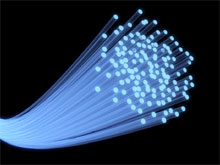Alcatel-Lucent, BT set 1.4 terabits per second internet speed record
24 Jan 2014
Even as internet users push for higher bandwidth, communication groups Alcatel-Lucent and BT have achieved a record internet speed of 1.4 tera bits per second with spectral efficiency of 5.7 bits per second Hz over core network during joint testing in London.
 With one byte being equivalent to eight bits, the bandwidth, according to BT would suffice to send 44 uncompressed HD movies each second. The blazing speeds were achieved with existing fibre cable technology between the 410 km fibre link between the BT Tower in London and BT's Adastral Park research campus in Suffolk.
With one byte being equivalent to eight bits, the bandwidth, according to BT would suffice to send 44 uncompressed HD movies each second. The blazing speeds were achieved with existing fibre cable technology between the 410 km fibre link between the BT Tower in London and BT's Adastral Park research campus in Suffolk.
''A a new 'flexible grid' infrastructure (Flexgrid) was also used to vary the gaps between transmission channels, usually set at 50 gigahertz. By increasing the density of channels on the fiber, this approach achieved up to 42.5% greater data transmission efficiency compared to today's standard networks,'' the Alcatel-Lucent website said.
According to experts, the success of the technology over existing infrastructure, held promise of path breaking real world applications, but consumer implementations are speculated to take a few years.
Asian countries have been leading the world's national average internet speed with South Korea holding the top most position at an average of 14 Mb per second, followed by Japan at an average of 11.6 Mbps, and Hong Kong at 9.3 Mb per second.
According to managing director of technology analyst firm Telsyte, Foad Fadaghi, who spoke to Fairfax Media, it a reaction to the growth in demand for video content. He added, it was about reducing the cost of carrying vast amounts of data over the coming years.
Agreeing, the chief executive of broadband analyst firm Point Topic, Oliver Johnson, told the BBC, BT and Alcatel-Lucent were making more from what they had got. He added, it allowed them to increase their capacity without having to spend much more money.
With the "flexigrid" infrastructure, researchers were able to create an "alien super channel" made up of seven 200 gigabits per second (Gbps) channels.
The total capacity of 1.4 terabits per second was achieved by combining the channels- the paths that data between two nodes on a networks.
According to Alcatel-Lucent optical marketing leader Kevin Drury, the technique was similar to decreasing the space between lanes on a busy freeway, to allow more lanes of traffic to travel on the same road.





















